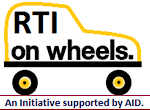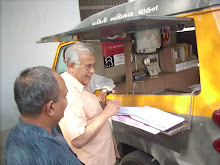Moneylife: Pune: Thursday, April 05, 2012.
It was only when they were informed that other localities were receiving 135 litres to 190 litres per day while they were receiving only 28 litres per day that they could seek legal intervention and the PMC was compelled to take appropriate action. In this case, any one of these questions would have been insufficient and asking each one of them through different RTI applications is obviously senseless.
Conclusion: Amendments should see the light of the day. For this, citizens and citizen pressure groups must be vocal.
The mischievous amendments to the RTI Act by the Maharashtra government have enraged RTI users and activists. Here’s why the government needs to backtrack
By now, the amendments proposed by the Maharashtra government in the RTI (Right to Information) Act have turned into a massive public outcry. Rightly so. Not only because they have been brought in surreptitiously, but because contents of the amendments too are ridiculous.
Let’s understand why the state government must back track immediately:
I. It cannot make any decision without keeping the people informed/consulted
According to Section 4 (1) (C) of the RTI Act, every public authority (government department) shall “publish all relevant facts while formulating important policies or announcing the decisions which affect public.’’
My comments: It needs to therefore undertake public consultations and opinions before it makes these amendments. Like Anna Hazare says, ‘they’ have forgotten that ‘we’ are a democracy.
II. Why only a pencil
The amendment says that an applicant will be allowed to bring in only a pencil when he/she goes for inspection of files. We, the people should not even have to visit a government office, as it is supposed to deliver us information at the click of the mouse. As per the Section 4 of the RTI Act, every government office (called public authority in government parlance) should suo moto display information. Here’s what the rule under Section 4 (2) and (3) says:
1. “Section (2) It shall be a constant endeavour of every public authority to take steps in accordance with the requirements of clause (b) of sub-section (1) to provide as much information suo motu to the public at regular intervals through various means of communications, including the Internet, so that the public have minimum resort to the use of this Act to obtain information.
Section (3) For the purposes of sub-section (1), every information shall be disseminated widely and in such form and manner which is easily accessible to the public.”
Also, Section 2 (i) states that information to the people has to be provided through various means like Photostat copies, images, manuscripts, files and so on, so the amendment to bring in only a pencil during inspection of documents is further irrelevant. Here’s what Section 2 (f) and (i) says:
Section 2 (f) ‘information’ means any material in any form, including records, documents, memos, e-mails, opinions, advices, press releases, circulars, orders, logbooks, contracts, reports, papers, samples, models, data material held in any electronic form and information relating to any private body which can be accessed by a public authority under any other law for the time being in force;
Section 2 (i) ‘Record’ includes:
By now, the amendments proposed by the Maharashtra government in the RTI (Right to Information) Act have turned into a massive public outcry. Rightly so. Not only because they have been brought in surreptitiously, but because contents of the amendments too are ridiculous.
Let’s understand why the state government must back track immediately:
I. It cannot make any decision without keeping the people informed/consulted
According to Section 4 (1) (C) of the RTI Act, every public authority (government department) shall “publish all relevant facts while formulating important policies or announcing the decisions which affect public.’’
My comments: It needs to therefore undertake public consultations and opinions before it makes these amendments. Like Anna Hazare says, ‘they’ have forgotten that ‘we’ are a democracy.
II. Why only a pencil
The amendment says that an applicant will be allowed to bring in only a pencil when he/she goes for inspection of files. We, the people should not even have to visit a government office, as it is supposed to deliver us information at the click of the mouse. As per the Section 4 of the RTI Act, every government office (called public authority in government parlance) should suo moto display information. Here’s what the rule under Section 4 (2) and (3) says:
1. “Section (2) It shall be a constant endeavour of every public authority to take steps in accordance with the requirements of clause (b) of sub-section (1) to provide as much information suo motu to the public at regular intervals through various means of communications, including the Internet, so that the public have minimum resort to the use of this Act to obtain information.
Section (3) For the purposes of sub-section (1), every information shall be disseminated widely and in such form and manner which is easily accessible to the public.”
Also, Section 2 (i) states that information to the people has to be provided through various means like Photostat copies, images, manuscripts, files and so on, so the amendment to bring in only a pencil during inspection of documents is further irrelevant. Here’s what Section 2 (f) and (i) says:
Section 2 (f) ‘information’ means any material in any form, including records, documents, memos, e-mails, opinions, advices, press releases, circulars, orders, logbooks, contracts, reports, papers, samples, models, data material held in any electronic form and information relating to any private body which can be accessed by a public authority under any other law for the time being in force;
Section 2 (i) ‘Record’ includes:
(a) any document, manuscript and file;
(b) any microfilm, microfiche and facsimile copy of a document;
(c) any reproduction of image or images embodied in such microfilm (whether enlarged or not); and
(d) any other material produced by a computer or any other device;
(j) “right to information” means the right to information accessible under this Act which is held by or under the control of any public authority and includes the right to—
(i) inspection of work, documents, records;
(ii) taking notes, extracts or certified copies of documents or records;
(iii) taking certified samples of material;
(iv) obtaining information in the form of diskettes, floppies, tapes, video
cassettes or in any other electronic mode or through printouts where such
information is stored in a computer or in any other device;
My comments: Hence, it is more appropriate that the state government issues a new circular to all government departments to upload all the information as per Section 4 and update it from time to time which again is mandatory under the RTI Act instead of dabbling in petty nothings like getting a pencil or a pen during inspection of files.
III. The state government been complaining that too many RTI applications has increased workload of its Public Information Officers (PIOs) and the new amendment will make it worse
According Section 6 (3) of the RTI Act, if the applicant asks a question which is not within the purview of the PIO, then he or she must transfer the application to the appropriate PIO within five days from the receipt of the application. Which means the onus lies with the PIO to ensure that the applicant is not unnecessarily harassed by making him or her run from pillar to post. Here’s what the rule says:
(3) Where an application is made to a public authority requesting for an information—
(i) which is held by another public authority; or
(ii) the subject matter of which is more closely connected with the
functions of another public authority, the public authority,to which such application is made, shall transfer the application or such part of it as may be appropriate to that other public authority and inform the applicant immediately about such transfer: Provided that the transfer of an application pursuant to this sub-section shall be made as soon as practicable but in no case later than five days from the date of receipt of the application.
My comments: Thus, presently, even if the citizen has filed the RTI application to the wrong government department, he or she need not worry as the PIO is required to forward it. With the new amendment, the state government is ridiculously asking the applicant to ask only one question “in not more than 150 words and that too pertaining to one subject matter” and has given liberty to the PIO to decline giving replies to every other query beyond the first one. Thus, the state government is not only suffocating dissemination of information but is increasing paper work for the citizen as well as the PIO through a series of RTI applications. The state government is clearly attempting to frustrate the citizen so that he or she will give up on the use of RTI, thus making this amendment malicious. It is simultaneously releasing the responsibility of the PIO as per Section 6 (3).
IV. It is reducing a RTI application to a near Twitter style by restricting it to 150 words. It is unpractical as often it is a string of questions that provide answer to one issue and gives a larger picture of the issue. Here’s an example:
A few years back, residents of Katraj were agitated due to very low water supply in their neighbourhood compared to other localities. They staged protests and even took out morchas to the municipal commissioner’s office and ward office. Both turned a deaf ear. So, they filed a RTI application to the Pune Municipal Corporation (PMC) asking the following questions:
(ii) taking notes, extracts or certified copies of documents or records;
(iii) taking certified samples of material;
(iv) obtaining information in the form of diskettes, floppies, tapes, video
cassettes or in any other electronic mode or through printouts where such
information is stored in a computer or in any other device;
My comments: Hence, it is more appropriate that the state government issues a new circular to all government departments to upload all the information as per Section 4 and update it from time to time which again is mandatory under the RTI Act instead of dabbling in petty nothings like getting a pencil or a pen during inspection of files.
III. The state government been complaining that too many RTI applications has increased workload of its Public Information Officers (PIOs) and the new amendment will make it worse
According Section 6 (3) of the RTI Act, if the applicant asks a question which is not within the purview of the PIO, then he or she must transfer the application to the appropriate PIO within five days from the receipt of the application. Which means the onus lies with the PIO to ensure that the applicant is not unnecessarily harassed by making him or her run from pillar to post. Here’s what the rule says:
(3) Where an application is made to a public authority requesting for an information—
(i) which is held by another public authority; or
(ii) the subject matter of which is more closely connected with the
functions of another public authority, the public authority,to which such application is made, shall transfer the application or such part of it as may be appropriate to that other public authority and inform the applicant immediately about such transfer: Provided that the transfer of an application pursuant to this sub-section shall be made as soon as practicable but in no case later than five days from the date of receipt of the application.
My comments: Thus, presently, even if the citizen has filed the RTI application to the wrong government department, he or she need not worry as the PIO is required to forward it. With the new amendment, the state government is ridiculously asking the applicant to ask only one question “in not more than 150 words and that too pertaining to one subject matter” and has given liberty to the PIO to decline giving replies to every other query beyond the first one. Thus, the state government is not only suffocating dissemination of information but is increasing paper work for the citizen as well as the PIO through a series of RTI applications. The state government is clearly attempting to frustrate the citizen so that he or she will give up on the use of RTI, thus making this amendment malicious. It is simultaneously releasing the responsibility of the PIO as per Section 6 (3).
IV. It is reducing a RTI application to a near Twitter style by restricting it to 150 words. It is unpractical as often it is a string of questions that provide answer to one issue and gives a larger picture of the issue. Here’s an example:
A few years back, residents of Katraj were agitated due to very low water supply in their neighbourhood compared to other localities. They staged protests and even took out morchas to the municipal commissioner’s office and ward office. Both turned a deaf ear. So, they filed a RTI application to the Pune Municipal Corporation (PMC) asking the following questions:
· How much water per person per day is provided to residents of Katraj
· How much water per person per day is provided to localities of (the application named five other localities of Pune)
· What is the reason for low supply of drinking water to Katraj ?
It was only when they were informed that other localities were receiving 135 litres to 190 litres per day while they were receiving only 28 litres per day that they could seek legal intervention and the PMC was compelled to take appropriate action. In this case, any one of these questions would have been insufficient and asking each one of them through different RTI applications is obviously senseless.
Conclusion: Amendments should see the light of the day. For this, citizens and citizen pressure groups must be vocal.














































































